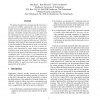Free Online Productivity Tools
i2Speak
i2Symbol
i2OCR
iTex2Img
iWeb2Print
iWeb2Shot
i2Type
iPdf2Split
iPdf2Merge
i2Bopomofo
i2Arabic
i2Style
i2Image
i2PDF
iLatex2Rtf
Sci2ools
DATE
2002
IEEE
2002
IEEE
Practical Instruction Set Design and Compiler Retargetability Using Static Resource Models
The design of application (-domain) specific instructionset processors (ASIPs), optimized for code size, has traditionally been accompanied by the necessity to program assembly, at least for the performance critical parts of the application. The highly encoded instruction sets simply lack the orthogonal structure present in e.g. VLIW processors, that allows efficient compilation. This lack of efficient compilation tools has also severely hampered the design space exploration of code-size efficient instruction sets, and correspondingly, their tuning to the application domain. In [13] a practical method is demonstrated to model a broad class of highly encoded instruction sets in terms of virtual resources easily interpreted by classic resource constrained schedulers (such as the popular list-scheduling algorithm), thereby allowing efficient compilation with well understood compilation tools. In this paper we will demonstrate the suitability of this model to also enable instruction ...
| Added | 14 Jul 2010 |
| Updated | 14 Jul 2010 |
| Type | Conference |
| Year | 2002 |
| Where | DATE |
| Authors | Qin Zhao, Bart Mesman, Twan Basten |
Comments (0)

